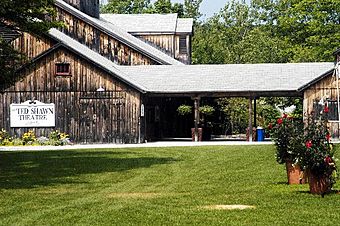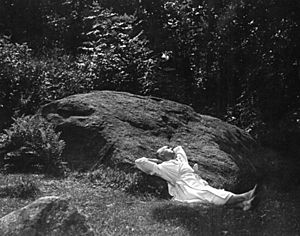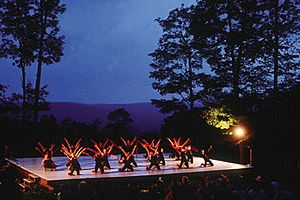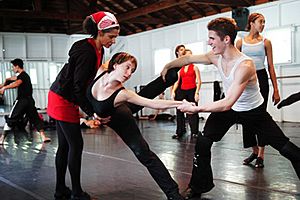Jacob's Pillow facts for kids
|
Jacob's Pillow
|
|

The Ted Shawn Theatre
|
|
| Location | George Carter Rd. Becket, Massachusetts, United States |
|---|---|
| Area | 220 acres (89 ha) |
| Built | 1931 |
| Architect | Joseph Franz |
| Architectural style | Federal, Bungalow/Craftsman |
| NRHP reference No. | 00001458 03000644 |
Quick facts for kids Significant dates |
|
| Added to NRHP | February 5, 2001 May 27, 2003 |
| Designated NHLD | May 27, 2003 |
Jacob's Pillow is a famous place in Becket, Massachusetts, where people learn about dance, practice it, and perform. It's like a special home for dance in the Berkshires region. The entire property was recognized as a National Historic Landmark District in 2003 because of its importance to American culture.
Contents
The Story of Jacob's Pillow
How Jacob's Pillow Got Its Name
The land where Jacob's Pillow stands was first settled in 1790 by a person named Jacob Carter III. The road leading up to his farm was very winding, like a zigzag path. People started calling it "Jacob's Ladder," which is a name from a story in the Bible. There was also a rock on the property that looked like a pillow. Because of these two things, the farm became known as "Jacob's Pillow."
A Dance Dream Begins
In 1931, a pioneer of modern dance named Ted Shawn bought the farm. He wanted to create a special place for dancers to train and create. Ted Shawn and his wife, Ruth St. Denis, had a very famous dance group called the Denishawn Company. They helped make dance forms popular that were inspired by theater and cultures from around the world, not just European ballet. Many important dancers, like Martha Graham and Jack Cole, learned from them.
Ted Shawn's big goal was to create a dance group just for American men. The dancers in his all-male company actually helped build many of the buildings at Jacob's Pillow. This special group ended in 1940 when the United States joined World War II. Most of the dancers went to serve in the military.
Saving Jacob's Pillow
After the war, Ted Shawn faced money problems and almost had to sell the property. In 1940, he rented it to a dance teacher, but her summer festival also struggled financially. Then, two famous British ballet stars, Alicia Markova and Anton Dolin, heard about Shawn's difficulties. They decided to buy the property to save it.
With help from a wealthy supporter named Reginald Wright, they raised $50,000. This money was used to buy the property and build a new theater. The summer dance festival started again, and Ted Shawn remained its director until he passed away in 1972.
National Recognition
In 2003, the United States government officially named Jacob's Pillow a National Historic Landmark District. This means it's a very important cultural place for everyone in America. It's the only dance organization in the U.S. to receive this special honor. In 2011, Jacob's Pillow also received the National Medal of Arts, which is a top national award for artistic excellence.
A Fire and Rebuilding
Sadly, the Doris Duke Theatre, one of the main indoor performance spaces, was destroyed in a fire on November 17, 2020.
Dance Performances
Jacob's Pillow showcases dance from all over the world. You can see many different styles, forms, and traditions here.
Famous Dancers and Companies
The founder, Ted Shawn, helped start the careers of dancers like Martha Graham and Jack Cole. Jacob's Pillow has continued this tradition of supporting new talent. Artists like Alvin Ailey, José Limón, and Mark Morris have been mentored here.
Many dance companies, such as Dance Theatre of Harlem and the Parsons Dance Company, performed for the first time at Jacob's Pillow. International groups like The Royal Danish Ballet and Nederlands Dans Theatre also made their U.S. debuts here. Famous choreographers like Merce Cunningham have created new works for the Pillow. Legendary dancers such as Margot Fonteyn and Mikhail Baryshnikov have also performed.
Performance Venues
Performances at Jacob's Pillow happen in two main places. The Ted Shawn Theatre was updated in 2022. It now has a new cooling system, an orchestra pit, and better access for artists and audience members. The stage is deeper, and the electrical system is modern.
The second place is the Henry J. Leir Stage. This is an outdoor stage where free performances are held. You can watch both new and established artists from around the world. It's a relaxed outdoor setting with beautiful views of the Berkshire hills.
Doris Duke Theatre
The Fire and Rebuilding Plans
The Doris Duke Theatre was built in 1990. It was one of the main performance spaces on the 220-acre campus of Jacob's Pillow. On November 17, 2020, the theater was completely destroyed by a fire.
In October 2023, Jacob's Pillow shared plans for the new Doris Duke Theatre. It was designed by Mecanoo, Marvel, and Jeffrey Gibson. The new theater will be twice as big as the old one. It will have special features like a fire pit and a medicinal garden. These features are a way to honor the Mohicans and other Native American tribes who lived in the area. The new theater will also have a green roof to collect rainwater and reduce noise.
The area behind the building, which was a casual gathering spot, will become an "artist quadrangle." The ground will be shaped for performances, and there will be more seating and large decorative rocks. Jacob's Pillow announced in late 2024 that the new theater is expected to open on July 9, 2025.
Community Programs
Jacob's Pillow offers several long-running programs for the community. These include Jacob's Pillow Curriculum in Motion and the Curriculum in Motion Institute. These programs help connect dance with education and local communities.
The School at Jacob's Pillow
The School at Jacob's Pillow is a special training program for dancers. It's based in the Perles Family Studio. The school offers five main programs: Ballet, Contemporary Traditions, Cultural Traditions, Tap/Musical Theatre, and the Ann & Weston Hicks Choreography Fellows Program.
Dancers at the school have a busy schedule. They take four professional-level classes each day, six days a week. They also have coaching sessions and perform for the public every week. They attend master classes with Festival artists and learn from dance scholars. Students also study in the Pillow's Archives and attend all Festival performances.
Notable Faculty and Alumni
Many famous dancers and choreographers have taught at The School at Jacob's Pillow. These include Susan Jaffe, Nikolaj Hubbe, Katherine Dunham, and Matt Mattox.
Graduates of the school have also become very successful. Some famous alumni include MacArthur Grant-winner Meredith Monk, choreographer Mia Michaels, and Nikolaj Hübbe, who is now the artistic director of the Royal Danish Ballet.
Archives
Preserving Dance History
The archives at Jacob's Pillow are like a huge treasure chest of dance history. The first collections were put together by the founder, Ted Shawn. Since the 1930s, volunteers and staff have continued to add materials. In 1991, Jacob's Pillow created a special job called Director of Preservation to manage the archives.
The archives hold about 6,000 films and videos, some dating back to 1894. There are also 45,000 historic dance photos, over 313,000 pages of unique printed materials, and 27 trunks full of costumes from 1915 onwards. Plus, there are 2,000 books about dance. The archives are part of a larger program that creates exhibits about dance, cares for the National Historic Landmark site, and records everything that happens at the Festival.
Accessing the Archives
The Jacob's Pillow archives are known around the world as a major collection of dance materials. Anyone can visit the research facility by making an appointment throughout the year. During the summer festival, it's open six days a week, from noon until the end of each performance. The entire collection is organized electronically, and much of it can be viewed on the Pillow's website.
Blake's Barn is an old building from the 1700s that was moved and rebuilt specifically for the archives. It was a gift from the dancer and actress Marge Champion and is named after her late son. The barn has a main area for exhibits and talks. It also has a reading room with video stations where you can watch the film collection. The lower level has temperature-controlled storage areas and equipment for making videos.
In 2011, Jacob's Pillow launched Jacob's Pillow Dance Interactive. This is an online resource with video clips from the archives. It features performances from the festival between 1937 and 2010, including rare footage. This free website lets you easily search for dance videos by artist, dance style, or time period. Each entry includes a video clip, information about the dancer or choreographer, and a picture.
See also
- List of National Historic Landmarks in Massachusetts
- National Register of Historic Places listings in Berkshire County, Massachusetts
- Ella Baff, who was the executive director of Jacob's Pillow Dance Festival from 1998 to 2015.






